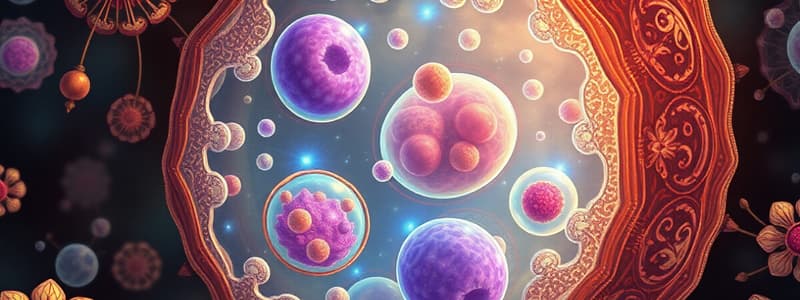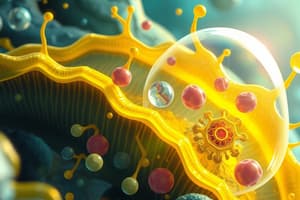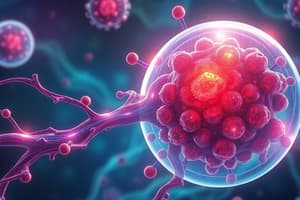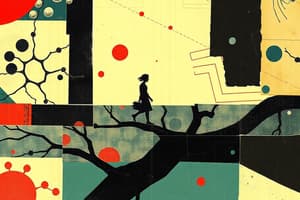Podcast
Questions and Answers
What is the primary role of the nucleus in eukaryotic cells?
What is the primary role of the nucleus in eukaryotic cells?
- Waste removal
- Protein synthesis
- Controls cell activities (correct)
- Energy production
Which organelle is responsible for photosynthesis in plant cells?
Which organelle is responsible for photosynthesis in plant cells?
- Chloroplasts (correct)
- Golgi apparatus
- Mitochondria
- Lysosomes
Which process moves substances against their concentration gradients using energy?
Which process moves substances against their concentration gradients using energy?
- Facilitated diffusion
- Diffusion
- Active transport (correct)
- Osmosis
What is the correct order of stages in cellular respiration?
What is the correct order of stages in cellular respiration?
What does a genotype refer to?
What does a genotype refer to?
In which part of photosynthesis does the Calvin cycle occur?
In which part of photosynthesis does the Calvin cycle occur?
What is the primary purpose of ribosomes in a cell?
What is the primary purpose of ribosomes in a cell?
Which of these processes uses glucose and produces ATP?
Which of these processes uses glucose and produces ATP?
What defines meiosis in terms of chromosome number?
What defines meiosis in terms of chromosome number?
Which of the following is NOT a form of evidence for evolution?
Which of the following is NOT a form of evidence for evolution?
What is the main focus of ecology?
What is the main focus of ecology?
What is taxonomy concerned with?
What is taxonomy concerned with?
Which statement best describes adaptations?
Which statement best describes adaptations?
Which of the following correctly describes the role of natural selection?
Which of the following correctly describes the role of natural selection?
Which human body system is primarily responsible for transporting oxygen?
Which human body system is primarily responsible for transporting oxygen?
What is speciation?
What is speciation?
Flashcards
Meiosis
Meiosis
Cell division producing gametes (sex cells) with half the chromosomes of the parent cell.
Mutation
Mutation
Changes in DNA sequences, potentially causing variations in traits.
Evolution
Evolution
Gradual genetic change in a population.
Natural Selection
Natural Selection
Signup and view all the flashcards
Ecology
Ecology
Signup and view all the flashcards
Taxonomy
Taxonomy
Signup and view all the flashcards
Ecosystem
Ecosystem
Signup and view all the flashcards
Biodiversity
Biodiversity
Signup and view all the flashcards
Prokaryotic Cell
Prokaryotic Cell
Signup and view all the flashcards
Eukaryotic Cell
Eukaryotic Cell
Signup and view all the flashcards
Cellular Respiration
Cellular Respiration
Signup and view all the flashcards
Photosynthesis
Photosynthesis
Signup and view all the flashcards
DNA
DNA
Signup and view all the flashcards
Gene
Gene
Signup and view all the flashcards
Diffusion
Diffusion
Signup and view all the flashcards
Active Transport
Active Transport
Signup and view all the flashcards
Study Notes
Cell Structure and Function
- Cells are the fundamental units of life, displaying diverse structures and functions.
- Prokaryotic cells (bacteria and archaea) lack membrane-bound organelles, while eukaryotic cells (plants, animals, fungi, protists) possess them.
- Key organelles include the nucleus (controls cell activities), mitochondria (energy production), ribosomes (protein synthesis), endoplasmic reticulum (protein and lipid synthesis), Golgi apparatus (protein modification and sorting), vacuoles (storage and support), chloroplasts (photosynthesis in plants), and lysosomes (waste removal).
- Cell membranes control the passage of substances in and out of the cell, exhibiting selective permeability.
- Passive transport (diffusion, osmosis, facilitated diffusion) moves substances along concentration gradients without energy input.
- Active transport moves substances against concentration gradients utilizing energy (e.g., ATP).
- Endocytosis and exocytosis facilitate the transport of large molecules into and out of the cell.
- Cells utilize energy for various functions, including maintaining homeostasis and self-replication.
Cellular Respiration and Photosynthesis
- Cellular respiration is the process where cells break down glucose to release energy in the form of ATP.
- The process occurs in three main stages: glycolysis, the Krebs cycle, and the electron transport chain.
- Photosynthesis is the process where plants and other autotrophs convert light energy into chemical energy in the form of glucose.
- The process involves two main stages: the light-dependent reactions and the light-independent reactions (Calvin cycle).
- Photosynthesis utilizes carbon dioxide, water, and light energy to produce glucose and oxygen.
- Cellular respiration takes in oxygen and releases carbon dioxide. These processes are deeply interconnected, with the products of one becoming the reactants of the other.
Genetics and Heredity
- DNA is the molecule that carries genetic information.
- DNA structure is a double helix with complementary base pairing (A with T, C with G).
- Genes are segments of DNA that code for proteins.
- Alleles are different forms of a gene.
- Genotype represents the genetic makeup, while phenotype describes observable traits.
- Mendel's laws of inheritance explain how traits are passed from parents to offspring.
- Dominant and recessive alleles determine trait expression in various patterns.
- Meiosis is a type of cell division that produces gametes (sex cells) with half the number of chromosomes compared to the parent cell.
- Mutations are alterations in DNA sequences, potentially leading to variations in traits.
Evolution and Biodiversity
- Evolution is the gradual change in the genetic makeup of a population over time.
- Natural selection is the process where organisms with traits better suited to their environment are more likely to survive and reproduce.
- Adaptations are inherited traits that enhance an organism's survival and reproduction.
- Biodiversity is the variety of life across all levels, from genes to ecosystems.
- Evidence for evolution includes fossil records, comparative anatomy, embryology, molecular biology, and biogeography.
- Speciation is the formation of new species.
Ecology
- Ecology studies the interactions between organisms and their environment.
- Levels of ecological organization include organisms, populations, communities, ecosystems, and biomes.
- Interactions include predator-prey relationships, resource competition, and symbiotic relationships (mutualism, commensalism, parasitism).
- Energy flows through ecosystems in food chains and food webs.
- Nutrient cycles (carbon, nitrogen, phosphorus) are essential for life processes.
Classification and Diversity of Living Things
- Taxonomy is the science of classifying organisms.
- The hierarchical classification system includes domains (Bacteria, Archaea, Eukarya), kingdoms, phyla, classes, orders, families, genera, and species.
- Characteristics of different groups of organisms (e.g., plants, animals, fungi, protists) need to be understood.
Human Body Systems
- The human body comprises various systems working together to maintain homeostasis.
- Organ systems include the skeletal, muscular, digestive, respiratory, circulatory, lymphatic, immune, nervous, endocrine, excretory, and reproductive systems.
- Each system has unique structures and functions.
- Interconnectedness of the systems allows for a full range of bodily functions.
Reproduction
- This section covers sexual and asexual reproduction in various organisms.
- Mitosis and meiosis are processes used for cell reproduction.
- Understanding the differences and similarities between these processes is important.
- Human reproductive systems and processes are included.
Environmental Interactions
- This section covers diverse aspects of environmental interactions.
- The interdependence of living and non-living environmental components needs to be understood.
- The impact of human activities on the environment is a frequent topic of study.
Studying That Suits You
Use AI to generate personalized quizzes and flashcards to suit your learning preferences.




